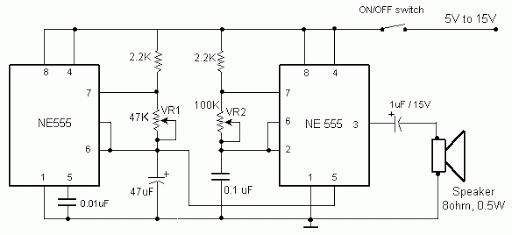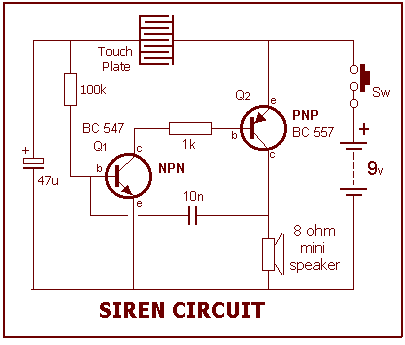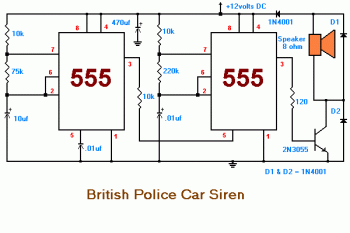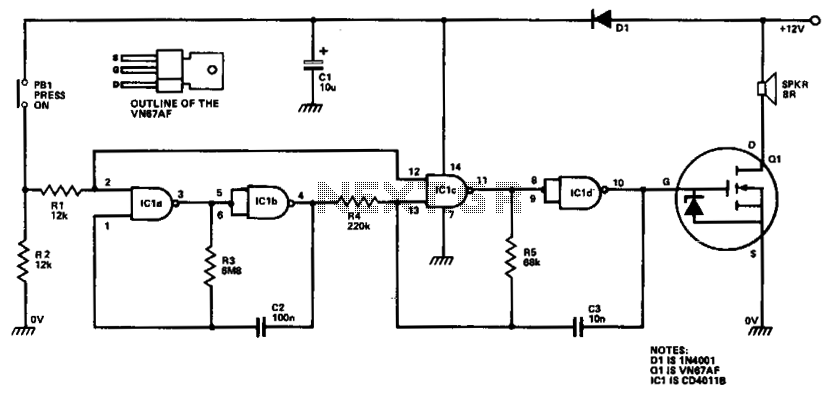
police siren pcb

This circuit generates a sound akin to a police siren. It utilizes two 555 timer integrated circuits (ICs) configured as astable multivibrators. The frequency is regulated by pin 5 of the IC. The first IC operates at approximately 1Hz, where a 47µF capacitor is charged and discharged periodically, resulting in a gradual increase and decrease in voltage. This varying voltage modulates the frequency of the second IC. This cycle repeats, producing a sound that closely resembles a police siren. Two variable resistors, VR1 and VR2, are included to adjust the siren's repetition period and tone. Adjusting VR1 changes the rate at which the siren transitions from high frequency to low frequency, while VR2 sets the overall siren frequency. Both VR1 and VR2 can be tuned to personal preference.
The circuit employs two 555 timer ICs, which are versatile components widely used in timer, delay, pulse generation, and oscillator applications. In this configuration, the first 555 timer is set up in astable mode, producing a square wave output at a frequency of approximately 1Hz. This frequency is determined by the resistors and the capacitor connected to the timer. The 47µF capacitor plays a crucial role in establishing the timing intervals, where it charges and discharges through the resistors connected to the discharge and threshold pins of the 555 timer.
The output from the first timer is not directly audible but serves as a control signal for the second 555 timer. The varying voltage from the first timer modulates the frequency of the second timer, which is also configured in astable mode. The result is a sound that oscillates between different frequencies, mimicking the characteristic rise and fall of a police siren.
Variable resistors VR1 and VR2 allow for customization of the siren's sound. VR1 adjusts the rate of frequency change, affecting how quickly the sound transitions from high to low frequencies, which can simulate various siren effects. VR2, on the other hand, controls the base frequency of the siren sound, allowing for further fine-tuning to achieve the desired pitch and tone.
This circuit can be powered by a standard DC power supply, and the output can be connected to a speaker to produce the audible siren sound. Care should be taken to ensure that the components are rated for the intended power supply voltage to prevent damage. The overall design is compact and can be easily integrated into various applications where a siren-like sound is required, such as alarm systems, toys, or novelty devices.This circuit produces a sound similar to the police siren. It makes use of two 555 timer ICs used as astable multivibrators. The frequency is controlled by the pin 5 of the IC. The first IC (left) is wired to work around 1Hz. The 47uF capacitor is charged and discharged periodically and the voltage across it gradually increases and decreases perio dically. This varying voltage modulates the frequency of the 2nd IC. This process repeats and what you hear is the sound remarkably similar to the police siren. Two presets VR1 and VR2 are provided to vary the siren period of repetition and the tone of the siren. By varying VR1 you can set how fast the siren changes from high freq. to low freq. VR2 sets the siren frequency. Adjust VR1 and VR2 to suit your taste. 🔗 External reference
The circuit employs two 555 timer ICs, which are versatile components widely used in timer, delay, pulse generation, and oscillator applications. In this configuration, the first 555 timer is set up in astable mode, producing a square wave output at a frequency of approximately 1Hz. This frequency is determined by the resistors and the capacitor connected to the timer. The 47µF capacitor plays a crucial role in establishing the timing intervals, where it charges and discharges through the resistors connected to the discharge and threshold pins of the 555 timer.
The output from the first timer is not directly audible but serves as a control signal for the second 555 timer. The varying voltage from the first timer modulates the frequency of the second timer, which is also configured in astable mode. The result is a sound that oscillates between different frequencies, mimicking the characteristic rise and fall of a police siren.
Variable resistors VR1 and VR2 allow for customization of the siren's sound. VR1 adjusts the rate of frequency change, affecting how quickly the sound transitions from high to low frequencies, which can simulate various siren effects. VR2, on the other hand, controls the base frequency of the siren sound, allowing for further fine-tuning to achieve the desired pitch and tone.
This circuit can be powered by a standard DC power supply, and the output can be connected to a speaker to produce the audible siren sound. Care should be taken to ensure that the components are rated for the intended power supply voltage to prevent damage. The overall design is compact and can be easily integrated into various applications where a siren-like sound is required, such as alarm systems, toys, or novelty devices.This circuit produces a sound similar to the police siren. It makes use of two 555 timer ICs used as astable multivibrators. The frequency is controlled by the pin 5 of the IC. The first IC (left) is wired to work around 1Hz. The 47uF capacitor is charged and discharged periodically and the voltage across it gradually increases and decreases perio dically. This varying voltage modulates the frequency of the 2nd IC. This process repeats and what you hear is the sound remarkably similar to the police siren. Two presets VR1 and VR2 are provided to vary the siren period of repetition and the tone of the siren. By varying VR1 you can set how fast the siren changes from high freq. to low freq. VR2 sets the siren frequency. Adjust VR1 and VR2 to suit your taste. 🔗 External reference





